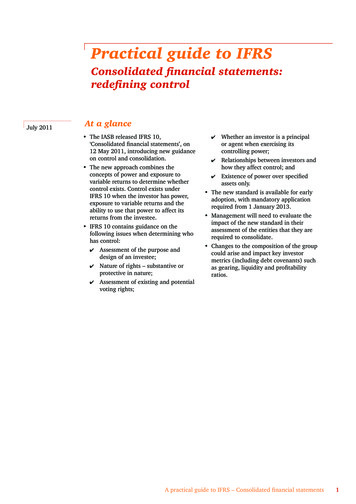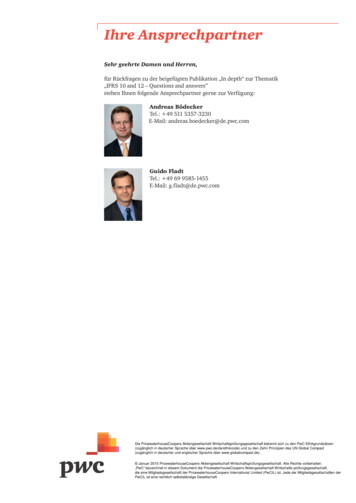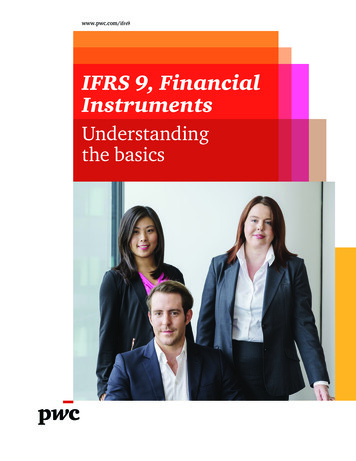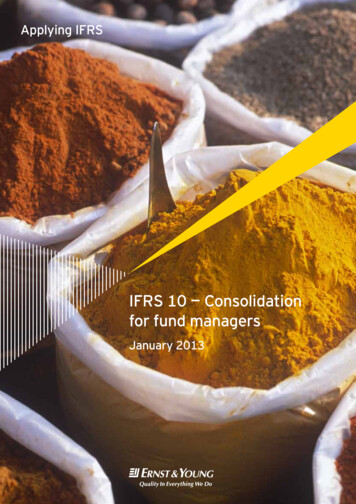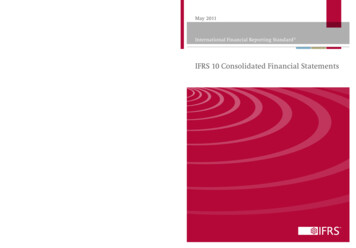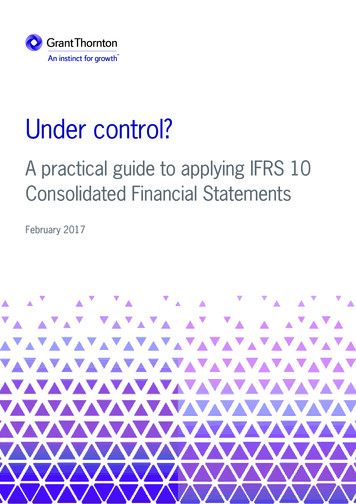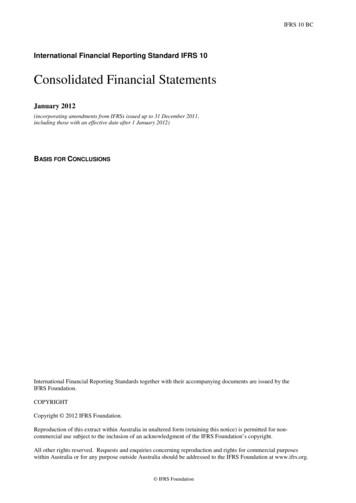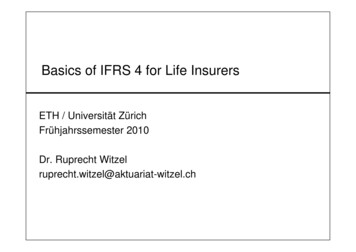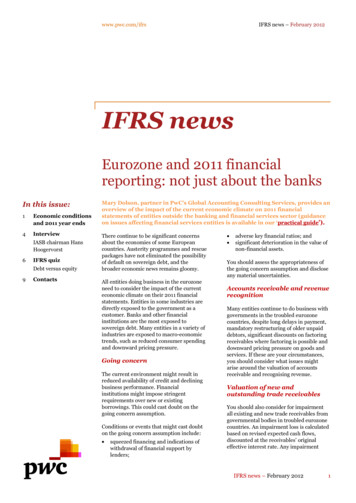
Transcription
www.pwc.com/ifrsItIFRS news – February 2012IFRS newsEurozone and 2011 financialreporting: not just about the banksIn this issue:1Economic conditionsand 2011 year ends4InterviewIASB chairman HansHoogervorst6IFRS quizDebt versus equity9ContactsMary Dolson, partner in PwC’s Global Accounting Consulting Services, provides anoverview of the impact of the current economic climate on 2011 financialstatements of entities outside the banking and financial services sector (guidanceon issues affecting financial services entities is available in our ‘practical guide’).There continue to be significant concernsabout the economies of some Europeancountries. Austerity programmes and rescuepackages have not eliminated the possibilityof default on sovereign debt, and thebroader economic news remains gloomy.All entities doing business in the eurozoneneed to consider the impact of the currenteconomic climate on their 2011 financialstatements. Entities in some industries aredirectly exposed to the government as acustomer. Banks and other financialinstitutions are the most exposed tosovereign debt. Many entities in a variety ofindustries are exposed to macro-economictrends, such as reduced consumer spendingand downward pricing pressure.Going concernThe current environment might result inreduced availability of credit and decliningbusiness performance. Financialinstitutions might impose stringentrequirements over new or existingborrowings. This could cast doubt on thegoing concern assumption.Conditions or events that might cast doubton the going concern assumption include:squeezed financing and indications ofwithdrawal of financial support bylenders;adverse key financial ratios; andsignificant deterioration in the value ofnon-financial assets.You should assess the appropriateness ofthe going concern assumption and discloseany material uncertainties.Accounts receivable and revenuerecognitionMany entities continue to do business withgovernments in the troubled eurozonecountries, despite long delays in payment,mandatory restructuring of older unpaiddebtors, significant discounts on factoringreceivables where factoring is possible anddownward pricing pressure on goods andservices. If these are your circumstances,you should consider what issues mightarise around the valuation of accountsreceivable and recognising revenue.Valuation of new andoutstanding trade receivablesYou should also consider for impairmentall existing and new trade receivables fromgovernmental bodies in troubled eurozonecountries. An impairment loss is calculatedbased on revised expected cash flows,discounted at the receivables’ originaleffective interest rate. Any impairmentIFRS news – February 20121
www.pwc.com/ifrscharge is recorded as a current-period baddebt expense.You should consider discounting, on initialrecognition, any receivables that are notexpected to be collected immediately. Thereis no ‘grace period’ in the revenue standardfor receivables that are collected within oneyear or any other specific period. You shoulddiscount accounts receivable at initialrecognition, with a consequential reductionin revenue, if the effect of discounting isexpected to be material.You should first determine if it is probablethat you will be paid for the goods you havereceived. Slow payment does not, on itsown, preclude revenue recognition.However, slow payment may well reducethe amount of revenue, because thecorresponding receivable will bediscounted.Revenue recognised might be furtherreduced by an estimate of discounts,clawbacks and future allowances thatgovernments might demand.Discounting requires estimating the date ofcollection and the actual amounts that willbe collected, and determining anappropriate interest rate to use.You should not recognised revenue if youdon’t expect to receive payment, or if youexpect discounts and allowances to bematerial but cannot estimate them.When estimating the date of collection, youshould use the most recent data availableon day-sales outstanding, adjusted for anyrecent developments.Non-financial asset impairmentThe appropriate discount rate is the rate atwhich the customer could otherwiseborrow on similar terms. For a governmentbody, a reasonable starting point forestimation is the most recent rate at whichthe relevant government body has beenable to borrow.Current economic difficulties will impactthe expected future cash flows to begenerated by long-term, non-financialassets such as goodwill, PPE and intangibleassets. If your business has significant nonfinancial assets relating to, located in orselling into any of the troubled eurozoneeconomies, you should consider the impactwhen measuring the recoverable amount ofnon-financial assets.Some receivables may be interest-bearingby statute; however, this does not removethe requirement to consider discounting.The rate of interest that government bodiesare paying is unlikely to be the same as therate at which receivables should bediscounted.The effects of the economic downturn couldimpact impairment calculations in severaldifferent ways, notably: triggeringimpairment reviews; affecting keyassumptions underlying management’s cashflow forecasts (growth, discount rates); andrequiring more sensitivity disclosures.Revenue recognitionYou should determine an impairment loss,if any, after calculating the recoverableamount. You also need to be alert to the useof over-optimistic assumptions inimpairment cash flow models in thecurrent environment.You also need to determine whetherrevenue should be recognised for currentsales, and the amount of revenue to berecognised. You have to meet all fiverevenue recognition criteria in IAS 18,‘Revenue’, in order to recognise revenue.The criteria that are most under stress inthe current environment are that:revenue can be measured reliably; andit is probable that economic benefitswill flow to the entity.Employee benefitsLong-term employee benefit liabilities,including defined benefit pensionobligations, are discounted using a ratebased on market yields at the balance sheetIFRS news – February 20122
www.pwc.com/ifrsdate on high-quality corporate bonds ofequivalent currency and term. The bondshould be rated at least AA to beconsidered ‘high quality’. Use market yields(at the balance sheet date) on governmentbonds of equivalent currency and term ifthere is no deep market in high-qualitycorporate bonds. Discount rates and otherassumptions are coming under morescrutiny in the current environment.TaxesEntities in the eurozone have a policychoice to consider discount rates either atthe level of the eurozone or the individualcountry. You should apply the policyconsistently from year to year, and anychange is a change in an accounting policy.A change from a eurozone corporate bondrate to a country government bond rate isunlikely to provide more reliable andrelevant information.Consider future reversals of existingdeferred tax liabilities, future taxable profitsand tax planning opportunities whenevaluating deferred tax assets. You shouldgive particular attention to the assumptionsunderlying expected taxable profits in futureperiods and to the requirement to haveconvincing evidence of future profits whenthe entity has a history of losses.You should scrutinise the recoverability ofdeferred tax assets, particularly whencurrent and expected future profits areadversely affected by market conditions.Deferred tax assets are recognised only tothe extent it is probable that future taxableprofit will be available against which theassets can be utilised.DisclosuresMany entities use actuaries to help deriveappropriate assumptions; actuaries usedifferent approaches to develop theiradvice. Where an actuary uses a differentmethodology from that used in priorperiods, you should bear in mindconsistency and applicability. A change inmethodology should lead to a ‘better’estimate of the appropriate discount rate,and should reflect available data aboutmarket yields and the benefit plan’sexpected cash flows.ProvisionsIAS 37, ‘Provisions’, requires provisions tobe discounted, typically starting with arisk-free rate. The sovereign debt crisisraises the question of whether adowngraded government credit ratingsmeans that government bond yields nolonger provide a risk-free rate.There are some countries for which all theratings agencies have acted to downgradegovernment bonds. The yield on thesebonds is unlikely to be a risk-free rate; youwill need to make some risk adjustment toestablish a risk-free rate. Judgement isneeded to determine whether governmentbonds remain risk free.Additional disclosures may well be requiredin the current economic environment;several regulators have already issuedguidance about their expectations in thisarea. IFRS 7, ‘Financial instruments:Disclosures’, is particularly relevant; takecare to ensure the objectives set out in thestandard are met. Further disclosures arerequired by IAS 1, ‘Presentation of financialstatements’. It may be necessary to makebroader disclosures about the impact of theEuropean economic environment on yourbusiness, financial instruments,concentration of risk and future.Subsequent eventsEvents may unfold quickly; you shouldconsider carefully whether you need toreflect events occurring between the balancesheet date and the date of authorisation inthe financial statements. Events are eitheradjusting or non-adjusting; many nonadjusting events will still require disclosure.You can find our guidance on economicpressures in the current environment fromthe topic summary: ‘Impacts of the currentmarket conditions’. Click this link or visitpwc.com/ifrs, ‘Additional PwC guidance’.IFRS news – February 20123
www.pwc.com/ifrsRaising standardsIASB chairman Hans Hoogervorst tells IFRS news about his approach to standardsetting and the challenges around the convergence agenda.What is the IASB’s overallstrategy?Hans HoogervorstTauraeIt’s pretty simple really. Our job is todevelop a single set of globally consistentfinancial reporting standards that deliverhigh-quality information to investors. Atthe same time, we are working withnational and regional public authorities, aswell as other international organisations, toencourage global adoption of thesestandards.In practice, that means completing ourcurrent work programme with the USFASB to the highest possible standard. Itmeans consulting on our future agenda andcontinuing to strengthen the institutionalrelationships between the IASB and ourstakeholders.What is the biggest challengeyou face over the short term?There are two primary challenges. The firstchallenge is for the IASB and the FASB tocomplete jointly the remaining convergenceprojects of revenue recognition, leasing andfinancial instruments. The second is toencourage the remaining major economiesto come on board.“The greatest obstacle[to every country oneday reporting underIFRS] is political will”On the first challenge, we are pretty faradvanced in our work to deliverimprovements to the revenue recognitionand leasing accounting standards. Giventhe importance of this work, we are reexposing for public comment both sets ofproposals. At the same time, we areconducting an unprecedented amount ofoutreach activities on these projects toensure we fully understand all of the issuesand, as far as possible, we have avoided anyunintended consequences.The remaining convergence project isfinancial instruments. I’m pretty hopefulthat we will get very close to a convergedsolution in many areas of the financialinstruments project. It’s a difficult task, asthe boards have been pulled in differentdirections. We’ve each tried to respond asbest we can, but this has made achievingconvergence very challenging.What are the criteria for a goodaccounting standard?In my view, a good accounting standard isone that delivers high-quality, comparableinformation to investors, but that does soin a way that minimises the burden onpreparers. The standards need to beapplicable across developed and emergingeconomies, auditable, enforceable and notlead to diversity in practice. It’s a tall order,but one that we take very seriously.There are various ways we achieve this. Wehave a geographically and professionallydiverse board of talented individuals. Ourwork benefits from a thorough, robust andcomprehensive due process. We welcomebroad participation in the standard-settingprocess, and we debate the differentviewpoints in a very transparent manner.We take the time to explain what we heard,how we responded and the rationale for thedecisions we have taken. And then werevisit the standard a few years after it hascome into effect, just to make sure it isworking as designed. That’s about as muchas anyone could expect.What is the greatest obstacle toevery country in the world oneday reporting under IFRS? Willit happen?Yes, I believe it will happen. The question iswhen and how. Global accountingstandards are an inevitable consequence ofglobally interconnected financial markets.The greatest obstacle is political will, andIFRS news – February 20124
www.pwc.com/ifrsthat is largely contained through therecommendations of the G20 Leaders andothers. Even in the US, support for globalaccounting standards is SEC policy and thepolicy of the US Government. However, theSEC is an independent agency and will gothrough its own independent decisionmaking process.How do you measure an IASBchairman’s success?“We should ‘call time’on the convergenceprogramme once thesefew remaining projectshave been completed”One of the most important things is respectfor the organisation and its work. Have wesought broad input throughout thestandard-setting process, given carefulconsideration to the issues, developed thebest possible standards, made sure theycan be applied around the world andsought to avoid unintended consequences?Not everyone will like the outcome, butrespect for the way we have gone about ourwork, as an independent standard-setter, isin my opinion the measure of our success.What are your thoughts on therecent SEC release of
discount accounts receivable at initial recognition, with a consequential reduction in revenue, if the effect of discounting is expected to be material. Discounting requires estimating the date of collection and the actual amounts that will be collected, and determining an appropriate interest rate to use. When estimating the date of collection, youFile Size: 359KBPage Count: 9
